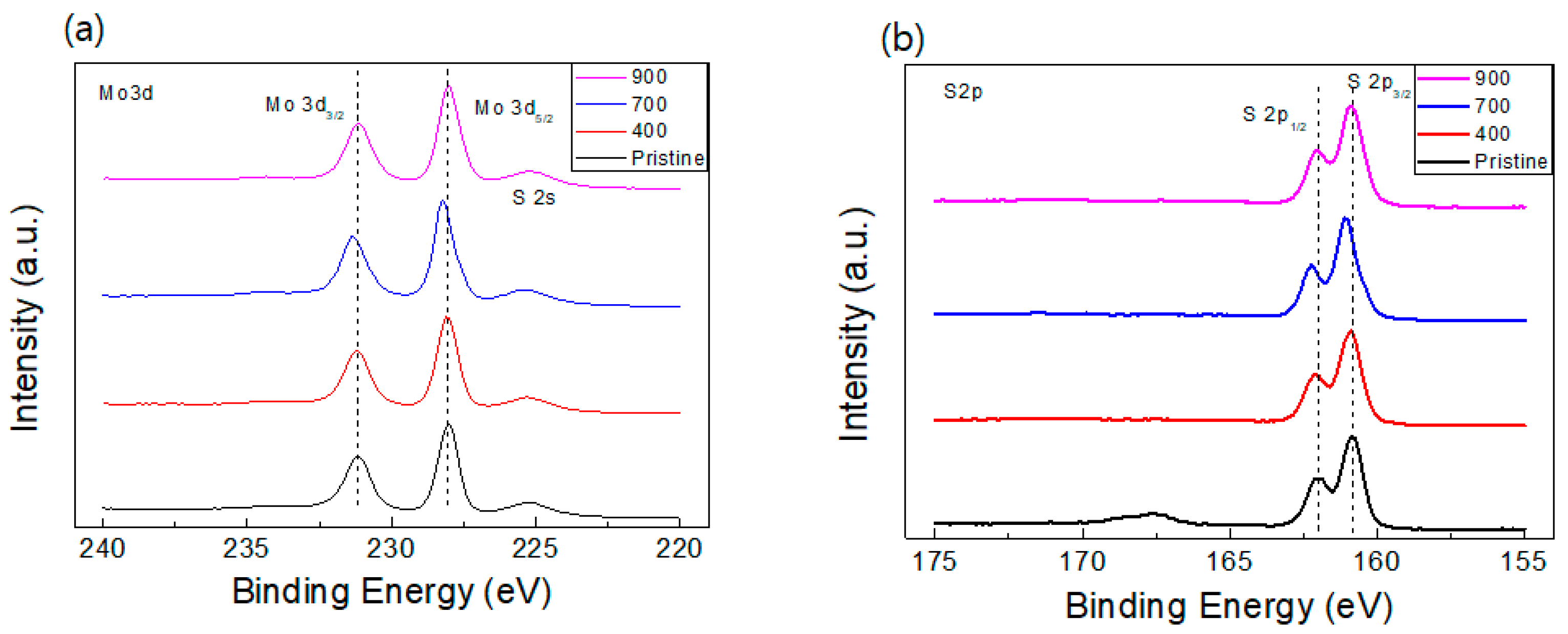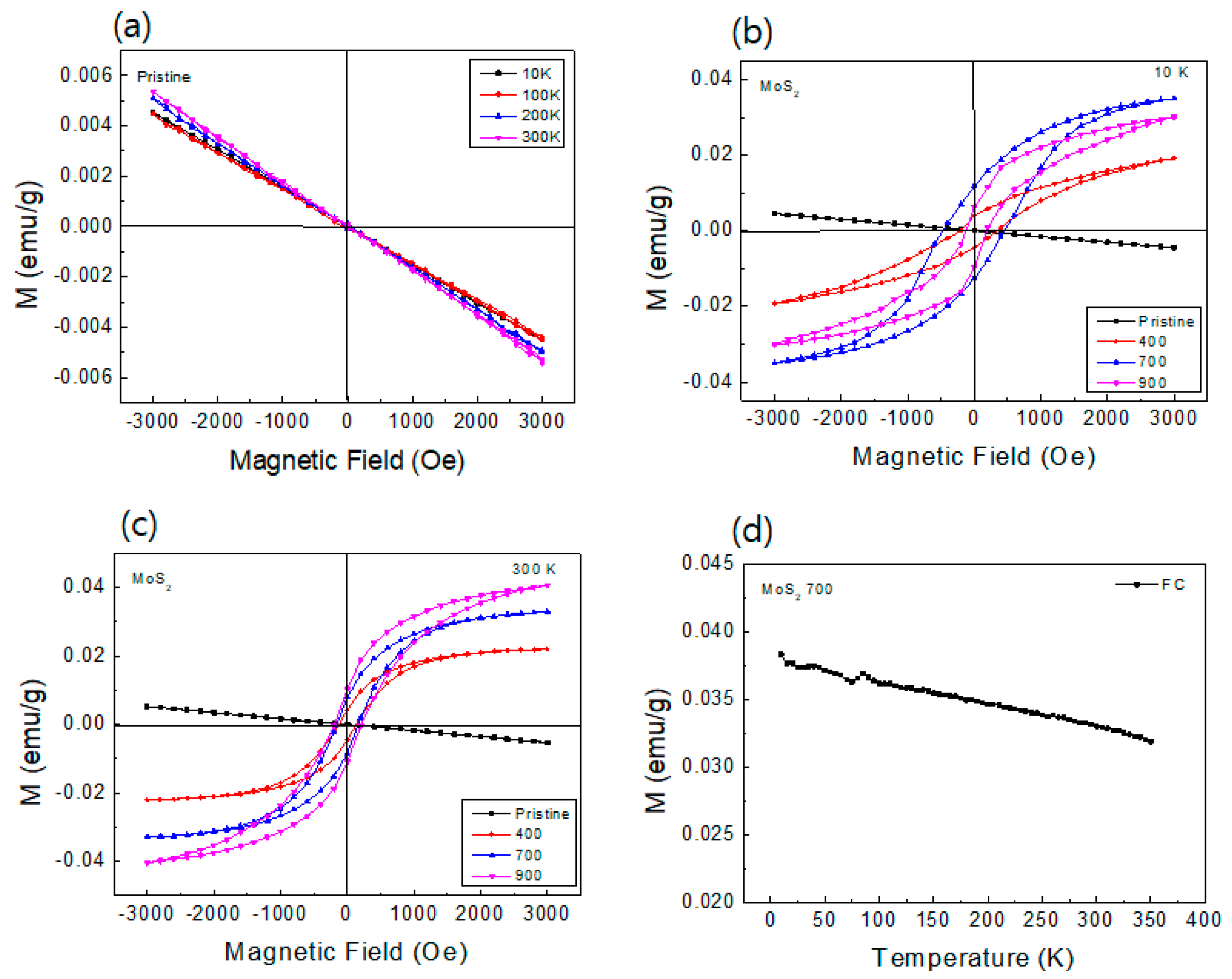Strong Room-Temperature Ferromagnetism of MoS2 Compound Produced by Defect Generation
Abstract
1. Introduction
2. Materials and Methods
3. Results and Discussion
3.1. XRD and Raman Spectra
3.2. XPS Spectra
3.3. EPR Spectra and TEM
3.4. Magnetization
4. Conclusions
Author Contributions
Funding
Data Availability Statement
Conflicts of Interest
References
- Ahmed, S.; Yi, J. Two-dimensional transition metal dichalcogenides and their charge Carrier mobilities in field-effect transistors. Nano-Micro Lett. 2017, 9, 50. [Google Scholar] [CrossRef]
- Nihan, K.P.; Mehmet, B. Investigation of single-wall MoS2 monolayer flakes grown by chemical vapor deposition. Nano-Micro Lett. 2015, 8, 70. [Google Scholar]
- Wang, Y.; Tseng, L.-T.; Murmu, P.P.; Bao, N.; Kennedy, J.; Ionesc, M.; Ding, J.; Suzuki, K.; Li, S.; Yiet, J. Defects engineering induced room temperature ferromagnetism in transition metal doped MoS2. Mater. Des. 2017, 121, 77. [Google Scholar] [CrossRef]
- Wu, W.; Wang, L.; Li, Y.; Zhang, F.; Lin, L.; Niu, S.; Chenet, D.; Zhang, X.; Hao, Y.; Heinz, T.F.; et al. Piezoelectricity of single-atomic-layer MoS2 for energy conversion and piezotronics. Nature 2014, 514, 470. [Google Scholar] [CrossRef]
- Wang, Q.H.; Kalantar-Zadeh, K.; Kis, A.; Coleman, J.N.; Strano, M.S. Electronics and optoelectronics of two-dimensional transition metal dichalcogenides. Nat. Nanotechnol. 2012, 7, 699. [Google Scholar] [CrossRef] [PubMed]
- Tongay, S.; Varnoosfaderani, S.S.; Appleton, B.R.; Wu, J.; Hebard, A.F. Magnetic properties of MoS2: Existence of ferromagnetism. Appl. Phys. Lett. 2012, 101, 123105. [Google Scholar] [CrossRef]
- Li, Y.; Zhou, Z.; Zhang, S.; Chenet, Z. MoS2 nanoribbons: High stability and unusual electronic and magnetic properties. J. Am. Chem. Soc. 2008, 130, 16739. [Google Scholar] [CrossRef]
- Ataca, C.; Şahin, H.; Aktürk, E.; Ciraci, S. Mechanical and electronic properties of MoS2 nanoribbons and their defects. J. Phys. Chem. C 2011, 115, 3934. [Google Scholar] [CrossRef]
- Ahmed, S.; Viboon, P.; Ding, X.; Bao, N.N.; Du, Y.H.; Herng, T.S.; Ding, J.; Yi, J.B. Annealing effect on the ferromagnetism of MoS2 nanoparticle. J. Alloy. Compd. 2018, 746, 399. [Google Scholar] [CrossRef]
- Shidpour, R.; Manteghian, M. A density functional study of strong local magnetism creation on MoS2 nanoribbon by sulfur vacancy. Nanoscale 2010, 2, 1429. [Google Scholar] [CrossRef]
- El-Mahalawy, S.H.; Evans, B.L. Temperature dependence of the electrical conductivity and hall coefficient in 2H-MoS2, MoSe2, WSe2, and MoTe2. Phys. Status Solidi B 1977, 79, 713. [Google Scholar] [CrossRef]
- El Beqqali, O.; Zorkani, I.; Rogemond, F.; Chermette, H.; Chaabane, R.B.; Gamoudi, M.; Guillaud, G. Electrical properties of molybdenum disulfide MoS2. Experimental study and density functional calculation results. Synth. Met. 1997, 90, 165. [Google Scholar] [CrossRef]
- Wilcoxon, J.P.; Newcomer, P.P.; Samara, G.A. Synthesis and otical properties of MoS2 and isomorphous nanoclusters in the quantum confinement regime. J. Appl. Phys. 1997, 8, 7934. [Google Scholar] [CrossRef]
- Eda, G.; Yamaguchi, H.; Voiry, D.; Fujita, T.; Chen, M.; Chhowallaet, M. Photoluminescence from chemically exfoliated MoS2. Nano Lett. 2011, 11, 5111. [Google Scholar] [CrossRef]
- Ganatra, R.; Zhang, Q. Few-Layer MoS2: A promising layered semiconductor. ACS Nano 2014, 8, 4074. [Google Scholar] [CrossRef]
- Li, X.; Zhu, H. Two-dimensional MoS2: Properties, preparation, and applications. J. Mater. 2015, 1, 33. [Google Scholar] [CrossRef]
- Andriotis, A.N.; Menon, M. Tunable magnetic properties of transition metal doped MoS2. Phys. Rev. B 2014, 90, 125304. [Google Scholar] [CrossRef]
- Fan, X.-L.; An, Y.-R.; Guo, W.-J. Ferromagnetism in transitional metal-doped MoS2 monolayer. Nanoscale Res. Lett. 2016, 11, 154. [Google Scholar] [CrossRef]
- Zhou, J.; Li, H.; Zhang, L.; Cheng, J.; Zhao, H.; Chu, W.; Yang, J.; Luo, Y.; Wu, Z. Tuning magnetism in transition-metal-doped 3C silicon carbide polytype. J. Phys. Chem. C 2011, 115, 253. [Google Scholar] [CrossRef]
- Xiang, Z.C.; Zhang, Z.; Xu, X.J.; Zhang, Q.; Wang, Q.B.; Yuan, C. Room-temperature ferromagnetism in Co doped MoS2 sheets. Phys. Chem. Chem. Phys. 2015, 17, 15822. [Google Scholar] [CrossRef]
- Wang, Y.; Li, S.; Yi, J. Electronic and magnetic properties of Co doped MoS2 monolayer. Sci. Rep. 2016, 6, 24153. [Google Scholar] [CrossRef]
- Prinz, G.A. Magnetoelectronics. Science 1998, 282, 1660. [Google Scholar] [CrossRef] [PubMed]
- Ohno, H. Making nonmagnetic semiconductors ferromagnetic. Science 1998, 281, 951. [Google Scholar] [CrossRef] [PubMed]
- Ohno, H.; Shen, A.; Matsukura, F.; Oiwa, A.; Endo, A.; Katsumoto, S.; Iye, Y. (Ga, Mn) As: A new diluted magnetic semiconductor based on GaAs. Appl. Phys. Lett. 1996, 69, 363. [Google Scholar] [CrossRef]
- Shon, Y.; Kwon, Y.H.; Yuldashev, S.U.; Leem, J.H.; Park, C.S.; Fu, D.J.; Kim, H.J.; Kang, T.W.; Fan, X.J. Optical and magnetic measurements of p-type GaN epilayers implanted with Mn+ ions. Appl. Phys. Lett. 2002, 81, 1845. [Google Scholar] [CrossRef]
- Shon, Y.; Lee, S.; Yoon, I.T.; Jeon, H.C.; Lee, D.J.; Kang, T.W.; Song, J.D.; Yoon, C.S.; Kim, D.Y.; Park, C.S. Clarification of enhanced ferromagnetism in Be-codoped InMnP fabricated using Mn/InP:Be bilayers grown by molecular beam epitaxy. Appl. Phys. Lett. 2011, 99, 192109. [Google Scholar] [CrossRef]
- Wang, Y.; Wang, J.; Ding, C.; Zhang, H.; Du, R.; Zhang, S.; Qian, J.; Hu, Y.; Huang, S. Laser-induced phenylation reaction to prepare semiconducting single-walled carbon nanotube arrays. Chem. Commun. 2020, 56, 14259. [Google Scholar] [CrossRef] [PubMed]
- Wang, Y.; Liu, D.; Zhang, H.; Wang, J.; Du, R.; Li, T.-T.; Qian, J.; Hu, Y.; Huang, S. Methylation-Induced Reversible Metallic-Semiconducting Transition of Single-Walled Carbon Nanotube Arrays for High-Performance Field-Effect Transistors. Nano Lett. 2020, 20, 496. [Google Scholar] [CrossRef]
- Li, H.; Zhang, Q.; Yap, C.C.R.; Tay, B.K.; Edwin, T.H.T.; Olivie, A.; Baillargeat, D. From bulk to monolayer MoS2: Evolution of Raman scattering. Adv. Funct. Mater. 2012, 22, 1385. [Google Scholar] [CrossRef]
- Chakraborty, B.; Bera, A.; Muthu, D.V.S.; Bhowmick, S.; Waghmare, U.V.; Sood, A.K. Symmetry-dependent phonon renormalization in monolayer MoS2 transistor. Phys. Rev. B 2012, 85, 161403. [Google Scholar] [CrossRef]
- Mao, N.N.; Chen, Y.F.; Liu, D.M.; Zhang, J.; Xie, L.M. Solvatochromic effect on the photoluminescence of MoS2 monolayers. Small 2013, 9, 1312. [Google Scholar] [CrossRef]
- Zhao, H.-Q.; Mao, X.; Zhou, D.; Feng, S.; Shi, X.; Ma, Y.; Wei, X.; Mao, Y. Bandgap modulation of MoS2 monolayer by thermal annealing and quick cooling. Nanoscale 2016, 8, 18995. [Google Scholar] [CrossRef] [PubMed]
- McDonnell, S.; Addou, R.; Buie, C.; Wallace, R.M.; Hinkle, C.L. Defect-dominated doping and contact resistance in MoS2. ACS Nano 2014, 8, 2880. [Google Scholar] [CrossRef] [PubMed]
- Zhang, K.; Feng, S.; Wang, J.; Azcatl, A.; Lu, N.; Addou, R.; Wang, N.; Zhou, C.; Lerach, J.; Bojan, V.; et al. Manganese Doping of Monolayer MoS2: The Substrate Is Critical. Nano Lett. 2015, 15, 6586. [Google Scholar] [CrossRef] [PubMed]
- Donarelli, M.; Bisti, F.; Perrozzi, F.; Ottaviano, L. Tunable sulfur desorption in exfoliated MoS2 by means of thermal annealing in ultra-high vacuum. Chem. Phys. Lett. 2013, 588, 198. [Google Scholar] [CrossRef]
- Arizumi, T.; Mizutani, T.; Shimakawa, K. EPR study on surface properties of ZnS and CdS. Jpn. J. Appl. Phys. 1969, 8, 1411. [Google Scholar] [CrossRef]
- Cai, L.; He, J.; Liu, Q.; Yao, T.; Chen, L.; Yan, W.; Hu, F.; Jiang, Y.; Zhao, Y.; Hu, T.; et al. Vacancy-induced ferromagnetism of MoS2 nanosheets. J. Am. Chem. Soc. 2015, 137, 2622. [Google Scholar] [CrossRef] [PubMed]
- Zheng, H.L.; Yang, B.S.; Wang, D.D.; Han, R.L.; Du, X.B.; Yan, Y. Tuning magnetism of monolayer MoS2 by doping vacancy and applying strain. Appl. Phys. Lett. 2014, 104, 132403. [Google Scholar] [CrossRef]
- Ding, X.; Liu, T.; Ahmed, S.; Bao, N.; Ding, J.; Yi, J. Enhanced ferromagnetism in WS2 via defect engineering. J. Alloy. Compd. 2019, 772, 740. [Google Scholar] [CrossRef]




Disclaimer/Publisher’s Note: The statements, opinions and data contained in all publications are solely those of the individual author(s) and contributor(s) and not of MDPI and/or the editor(s). MDPI and/or the editor(s) disclaim responsibility for any injury to people or property resulting from any ideas, methods, instructions or products referred to in the content. |
© 2024 by the authors. Licensee MDPI, Basel, Switzerland. This article is an open access article distributed under the terms and conditions of the Creative Commons Attribution (CC BY) license (https://creativecommons.org/licenses/by/4.0/).
Share and Cite
Park, C.-S.; Kwon, Y.; Kim, Y.; Cho, H.D.; Kim, H.; Yang, W.; Kim, D.Y. Strong Room-Temperature Ferromagnetism of MoS2 Compound Produced by Defect Generation. Nanomaterials 2024, 14, 334. https://doi.org/10.3390/nano14040334
Park C-S, Kwon Y, Kim Y, Cho HD, Kim H, Yang W, Kim DY. Strong Room-Temperature Ferromagnetism of MoS2 Compound Produced by Defect Generation. Nanomaterials. 2024; 14(4):334. https://doi.org/10.3390/nano14040334
Chicago/Turabian StylePark, Chang-Soo, Younghae Kwon, Youjoong Kim, Hak Dong Cho, Heetae Kim, Woochul Yang, and Deuk Young Kim. 2024. "Strong Room-Temperature Ferromagnetism of MoS2 Compound Produced by Defect Generation" Nanomaterials 14, no. 4: 334. https://doi.org/10.3390/nano14040334
APA StylePark, C.-S., Kwon, Y., Kim, Y., Cho, H. D., Kim, H., Yang, W., & Kim, D. Y. (2024). Strong Room-Temperature Ferromagnetism of MoS2 Compound Produced by Defect Generation. Nanomaterials, 14(4), 334. https://doi.org/10.3390/nano14040334





